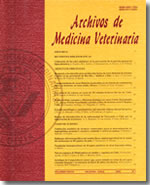Characterisation of skin bruises and identification of risk factors during pre-slaughter handling in commercial pigs
Main Article Content
Abstract
The goal of this study was to describe the gross characteristics of skin bruises and describe risk factors for pre-slaughter pigs. A total of 134 journeys (3,156 pigs) from a Colombian commercial slaughterhouse were surveyed. A multivariate logistic regression was used to assess the risk factors prior to slaughter. The condition of skin bruises was described as a binomial response (1: slight damage, 2: severe damage). The prevalence of skin bruises was 100.0%, mean 6.1 bruises/carcass. Coma shaped bruises were most frequent (71.8%), followed by linear (14.4%), and diffuse shaped bruises (10.8%). Factors such as mixing unfamiliar pigs in the farm, speed of the truck, prolonged journey stops, and lairage time (P < 0.01) influenced the occurrence of skin bruises. Inspection of the animals during the journey decreased the prevalence of skin bruises.

